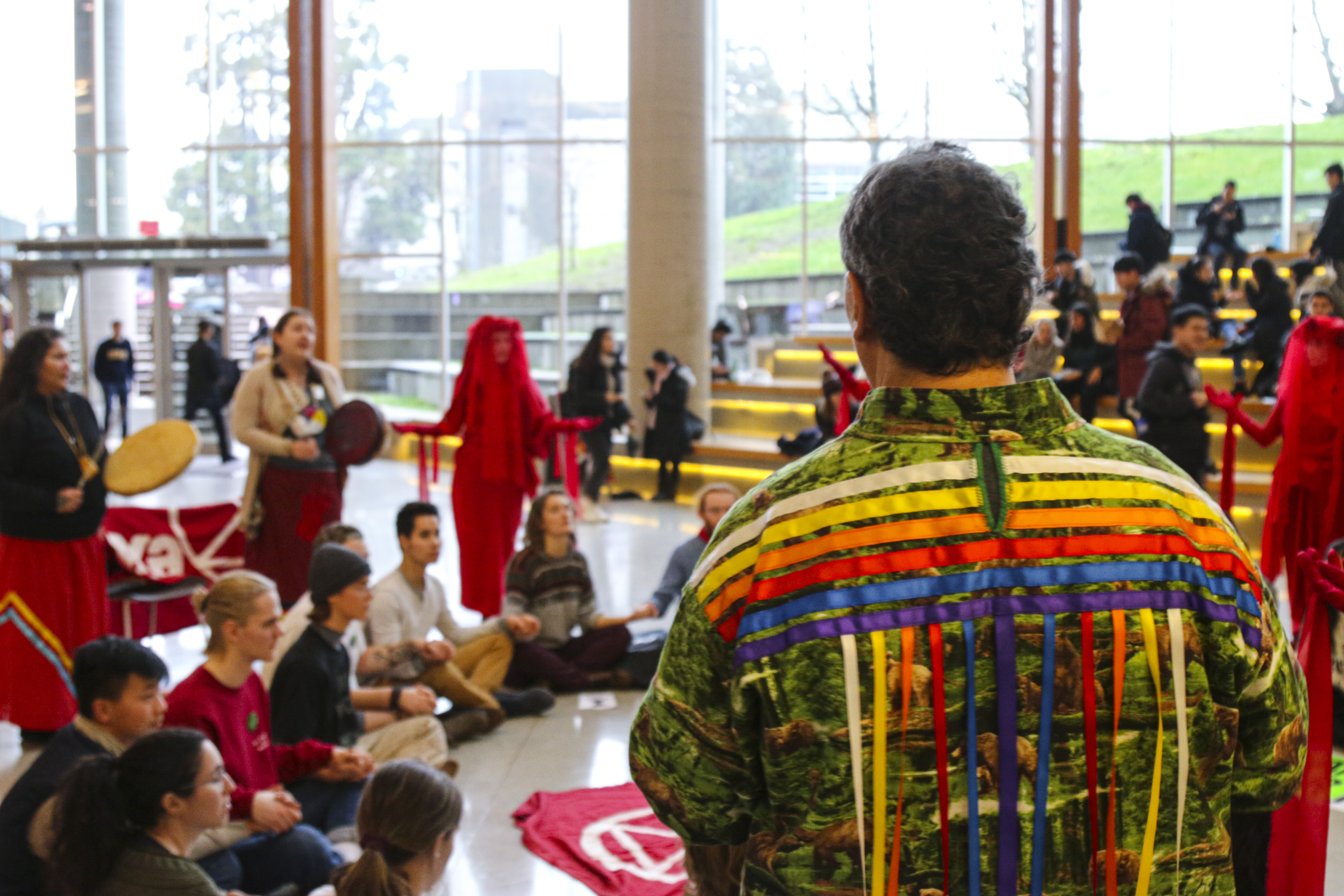When Claire Jones stepped into the apartment of her husband’s late uncle for the first time, she discovered what looked like the trappings of a carnival.
Art
The art of resistance art on campus – Ubyssey Online
Art is defining student activist movements in a world that’s increasingly moving to social media. The visual side of activism has evolved to encompass new forms with students embracing performance and Lennon Walls — but despite the shift online, one medium remains especially striking: the protest sign.
The sense of community was undeniable at a recent UBCC350 sign-making event and I hesitated to pull members Max Hiscox and Mukta Chachra away from the camaraderie for an interview. They were preparing for solidarity action with Wet’suwet’en land defender that was being held at Vancouver- area ports later the same afternoon.
A dozen or so students cut up cardboard and gather markers while sitting on the floor or perched on couches. They passed around a bag of chips, amidst typical student chatter about some concert the week before or the shortcomings of some professor.
“It’s a space for people to build art and at the same time talk to each other about what’s going on and organize,” said Hiscox.
There’s more nuance to activist art than just protest, however, and the simple sign goes beyond protest.
“I don’t even like to call them protest signs,” Chachra said. “I think it’s more like art and it’s the art of resistance.”
Sign slogans assert a certain kind of defiance. Take the worldwide climate strikes led by activists like Autumn Peltier and Greta Thunberg, where photos of protest signs struck the internet with snappy slogans.
Chachra acknowledged the space she occupies with her activism, stressing the need to centre the voices of the communities most impacted.
“With our signs, I think it’s really important to echo the voices of the people at the front lines, and … for those of us in the more privileged position to support those communities and … their voices in art,” she said.
Finding space in the impermanent
Although signage will almost certainly continue as a mainstay in activism, campus activist groups — such as UBCC350 — have been exploring the usage of more fluid mediums, like screen printing and chants in their activism.
The Lennon Walls across campus also show how spontaneous mediums of protest can have an impact at UBC, as they provide a space for students to write messages about the recent protest movement in Hong Kong. Walk by the wall and you’ll see a motley patch of coloured
Post-its upon which students have scrawled messages of support for pro-Hong Kong activists.
Of note is the ubiquitous 加 油, literally translated as “add oil,” a common Chinese phrase of encouragement. Beside a photo memorializing the late Dr. Li Wenliang, who was a COVID-19 whistleblower, are pens and pads of blank notes for passersby to write and stick on their own thoughts.
Phoenix Au-Yeung, an executive at UBC The Enlightenment of HK, said the wall in the Nest started in a “half organic” way after a rally on campus in October 2019.
“We just thought this might be a chance for everyone to kind of fill up this Lennon Wall, which is a really common way of expressing opinions … in Hong Kong,” she said. “So from then on, we’ve seen people putting on Post-it Notes.”
One of the most eye-catching visuals of Hong Kong activism, Lennon Walls in Hong Kong feature Post-its that are typically glued down in public spaces. The notes provide an easily accessible way for anybody to contribute to an installation — “You probably have one in your backpack right now,” Au-Yeung mused — and it’s already spawned an offshoot for Kashmir in the Life Building.
But the transience of the notes is one of the wall’s greatest vulnerabilities. The installation in the Nest has endured several instances of vandalism, despite the AMS’s approval for the wall to remain.
The wall’s resilience symbolizes the people in the movement, said Au-Yeung, even as media attention has waned. “We’re still here,” she said.
“It’s really exciting to see that there are still people caring, especially [since] we’re all the way here in Canada,” she said. “They’re still willing to kind of put themselves out there … just leaving a message that is letting other people know that they’re caring.”
And it’s neither Au-Yeung nor the rest of Enlightenment’s role to police the messages put up, she said. The wall is open to all, both pro-HK and pro-Chinese government sentiments.
“What we were really upset about [with] the last wall being torn down was that we never stopped you from putting anything on,” she said.
“It could be anything. It could be pro-China. But you didn’t have the right to tear down what other people had to say because those are their thoughts, their property and their rights — and you shouldn’t be able to remove that from the public attention.”
Good press, bad press
By nature, the visual impact of activist art lends itself to being taken up by the media. But Au-Yeung said that media attention is a “side product of the wall.”
“I believe that this should be something that comes together naturally, that exists because people want to present their thoughts and they want to share what’s on their minds.”
Emma Pham, a member of Extinction Rebellion (XR) UBC, holds a different philosophy.
“I think that art is very important in this because this movement is based in the 21st century. There’s nothing better than a good photo.”
XR is more focused on taking up space in media than the other activist organizations I spoke to. For example, events like last month’s road blockades in solidarity with Wet’suwet’en or the hunger strike for divestment in January were both aimed at bringing media attention to XR and its mission. The latter featured chants from the Red Brigade, an activist group tied to XR that brings performance to protests with members clad in signature blood-red livery.
“That’s something that’s kept in mind during disruptive actions,” said Pham, one of the hunger strikers. “Is it going to be enticing for media to be there? Is there going to be a good story or a good photo they can get out of it?”
On the other hand, some have criticized XR for its focus on grabbing attention instead of policy change.
Personally, Chachra said she has issues with media coverage of activism. She said, consider Wet’suwet’en land defenders, whom news outlets and social media users have branded as ‘protesters,’ despite their goal of resisting the RCMP to defend their ancestral lands.
“It’s not a protest because they are Indigenous water and land defenders, and they’re protecting their territory which has never been surrendered.”
Even if the narrative is out of their control, there are still benefits to media attention, said Hiscox. It’s especially important for Wet’suwet’en land defenders, he explained, because spreading awareness about RCMP actions around the Unist’ot’en camp keeps resisters safe.
“I think we’re trying to make it really clear that this genocide and removal of Indigenous people from the land is not something that will be tolerated,” he said. “It’s not something that will just cause a stir for a bit and will blow over. It’s something that absolutely will not go unnoticed.”
And for many student activists at UBC, there will be resistance as long as conflict persists. With tensions in Hong Kong becoming less intense in recent months, I asked Au-Yeung what she saw for the future of the Lennon Wall.
“I hope it could stay up as long as the movement’s going on,” she said. “As long as we’re still fighting in Hong Kong and everywhere else in the world.
“Ultimately [the Lennon Wall] could just be a platform for anyone to say anything they want.”
Art
British government deems man’s art-filled apartment a historic site – The Washington Post


A giant concrete sculpture of a roaring lion’s head stood in the living room, enveloping the fireplace. Looming in the next room was a giant Minotaur head. Papier-mâché sculptures littered the hallways and colorful murals adorned every wall and ceiling, even in the bathroom.
Jones and her family had known Ron Gittins as an eccentric and solitary artist. But they hadn’t realized until shortly after he died in 2019 at age 79 that he had carved, sculpted and painted his passion onto the walls of his rented apartment in Birkenhead, a riverside town in northwestern England where he lived alone.
It couldn’t stay, Gittins’s landlord had said. But Jones knew she wanted to preserve the scene.
“I was just kind of like, ‘We can’t just let this go,’” she told The Washington Post.
For years, Gittins’s family worked to protect his whimsical life’s work, insisting that the apartment, “Ron’s Place,” was an irreplaceable art installation worthy of preservation. This month, the British government agreed. Historic England, a national body that designates historically significant sites in England, added Ron’s Place to its National Heritage List, the family announced in early April.
The designation, which forbids an owner from making changes to Ron’s Place without governmental consent, places Gittins’s apartment among the ranks of the medieval churches and Victorian villas that usually receive such recognition in the country, securing an unlikely legacy for Gittins’s creation. The apartment received a Grade II listing, which is given to “particularly important buildings of more than special interest,” according to Historic England.
“This was Ron, who led a very small, private life,” said Paul Kelly, a board member of the Wirral Arts and Culture Community Land Trust, an organization created to manage Ron’s Place. “Suddenly, he was being recognized as having done something of interest on that scale. … What an extraordinary thing.”
Gittins, a self-employed artist and theater performer, was an outcast of sorts among his family, his niece Jan Williams wrote to The Post. He showed up at reunions in flamboyant outfits and spoke in codes, joking that he was a secret agent. He was known in Birkenhead as the local eccentric who sometimes strutted around town dressed as a Roman centurion.
He was, Williams said, “colorful, larger than life, loud, opinionated, argumentative yet affectionate.”
Gittins kept his family at a distance. He let few people into his apartment, which his rental agreement had permitted him to decorate “to his own taste,” according to the Ron’s Place website.
Walking into Gittins’s home after his death felt like finally discovering the world he’d been inhabiting, Williams said. The lion’s head glistened with eyes made from shards of glass, and a frying pan sat in its mouth. Strewn around the apartment were smaller models, like an Egyptian sarcophagus that opened up to reveal a model mummy. While sorting through Gittins’s possessions, Williams found a postcard he had written addressed to her, saying that he couldn’t wait to show her his creations.
“Ron had created a fantasy world for his own pleasure,” Williams said. “A sort of stage set where he played the leading role.”
Williams, herself an artist and photographer, led the effort to save Gittins’s apartment. She first arranged to keep renting the apartment from his landlord, fundraising to cover the cost and forming a community organization to manage the space. Endorsements trickled in from singers, authors and sculptors who visited Ron’s Place at the family’s invitation. They landed a story in the Guardian and a video feature from the BBC.
In November 2022, the building that housed Ron’s Place was put up for auction. Buyers circled, and Williams scrambled to raise the hundreds of thousands of dollars they needed to win a bidding war. It ended in a “fairytale-style” miracle, Williams said: On March 1, 2023, the last day of the auction, a donor emailed with an offer to lend Williams’s organization most of the money it needed to purchase the building for about $400,000. The donor told Williams she had learned about Ron’s Place that morning, while reading the newspaper on her commute.
“It felt as if it was meant to be,” Williams said.
In a Hail Mary bid to delay the sale, Williams had also petitioned Historic England to list Ron’s Place as historically significant. It was a long shot — the designation is normally given to churches, inns and manors with centuries’ more history than Gittins’s apartment.
Historic England, however, heeded her request, even after Williams and the land trust secured ownership of Ron’s Place. When Sarah Charlesworth, an evaluator with Historic England, visited the apartment later that year, she immediately noticed the same floor-to-ceiling lion statue that had greeted Williams and Jones years earlier.
“I was actually thinking ‘This is a slam dunk’ as soon as I came in,” Charlesworth said.
Ron’s Place seemed to her like a striking example of “outsider art” — artwork created by people with no formal artistic training and without the intention of being exhibited or sold. It was, Charlesworth said, a facet of Britain’s history just as worthy of preservation as its churches and castles.
“Listing is not just about stately homes and chocolate box cottages,” she said. “It is about being representative and inclusive and making sure that we do represent all aspects of the nation’s history.”
The apartment is closed to visitors as it undergoes repairs. Williams and Kelly, the Wirral Arts and Culture Community Land Trust board member, said the organization has plans after acquiring the entire building that houses Ron’s Place, which also includes a garden and three upstairs apartments. They hope to preserve Gittins’s artwork on the ground floor as a museum and art space and renovate the other apartments into low-cost housing units for artists.
It’s an unlikely legacy for Gittins after devoting much of his life to the secret world in his apartment, Kelly said. But he thinks Gittins would be pleased to see others taking notice.
“Ron was a real outsider,” Kelly said. “But … this has been recognition for his work. He would be loving it.”
Art
PARIS RESTAURANT PLÉNITUDE IS REVEALED AS THE RECIPIENT OF THE ART OF HOSPITALITY AWARD 2024 … – Yahoo Canada Finance
Announced in advance of the awards ceremony for the first time ever, this accolade seeks to help raise the profile of the art of hospitality
LONDON, April 18, 2024 /CNW/ — Paris restaurant Plénitude is revealed as the recipient of the Art of Hospitality Award 2024 from The World’s 50 Best Restaurants, ahead of the official ceremony taking place in Las Vegas in June.
Located on the first floor of the French capital’s Cheval Blanc Paris, Chef Arnaud Donckele and Director Alexandre Larvoir have created in Plénitude an ode to the tradition of French fine dining, spending two years choosing the crockery, artisans, ceramicist and fabrics that help to create the restaurant’s intimate ambiance. With just 30 covers, every detail delivers an intimate experience for its diners, complete with the restaurant’s signature French elegance.
ADVERTISEMENT
Normandy-born Chef Donckele, who also runs Cheval Blanc Saint-Tropez fine dining restaurant La Vague d’Or, has taken on the role of master perfumer in his creations to make sauces, known as the essence of French cuisine. In his hands, each is treated like a perfume or liquid painting, created such that the sauces are the main event, with meat and fish as their complements. Under the leadership of Larvoir, the restaurant’s impeccable service team knows Donckele’s creations intimately and conveys their essence to guests stepping through the door of Cheval Blanc Paris, which was placed at No.34 on The World’s 50 Best Hotels 2023.
William Drew, Director of Content for The World’s 50 Best Restaurants, says: “We are thrilled to announce Plénitude as the winner of this year’s Art of Hospitality Award. Despite its relative youth, this Paris restaurant has been making waves on the global gastronomy scene for its flawless and inventive approach, celebrating the art of service and showing the world that French hospitality remains at the top of its game.”
Chef Donckele says: “Give yourself the pleasure of giving pleasure.” Larvoir adds: “At Plénitude, service is a wonderful encounter at every table. We seek to welcome our guests as if they were at home, to discover and understand them, to captivate and move them thanks to Arnaud’s fabulous sauces, to make them laugh too, before leaving them with the sincere wish to see them again soon.”
Photo – https://mma.prnewswire.com/media/2388561/50_Best_Paris_restaurant_Plenitude.jpg
Logo – https://mma.prnewswire.com/media/2361814/4610851/World_50_Best_2024_Logo.jpg
Media centre:
https://mediacentre.theworlds50best.com


View original content to download multimedia:https://www.prnewswire.com/news-releases/paris-restaurant-plenitude-is-revealed-as-the-recipient-of-the-art-of-hospitality-award-2024-by-the-worlds-50-best-restaurants-302120759.html
SOURCE 50 Best


View original content to download multimedia: http://www.newswire.ca/en/releases/archive/April2024/18/c5640.html
Art
Canada's art installation at Venice Biennale rooted in research, history, beauty – Hamilton Spectator


/* OOVVUU Targeting */
const path = ‘/entertainment’;
const siteName = ‘thespec.com’;
let domain = ‘thestar.com’;
if (siteName === ‘thestar.com’)
domain = ‘thestar.com’;
else if (siteName === ‘niagarafallsreview.ca’)
domain = ‘niagara_falls_review’;
else if (siteName === ‘stcatharinesstandard.ca’)
domain = ‘st_catharines_standard’;
else if (siteName === ‘thepeterboroughexaminer.com’)
domain = ‘the_peterborough_examiner’;
else if (siteName === ‘therecord.com’)
domain = ‘the_record’;
else if (siteName === ‘thespec.com’)
domain = ‘the_spec’;
else if (siteName === ‘wellandtribune.ca’)
domain = ‘welland_tribune’;
else if (siteName === ‘bramptonguardian.com’)
domain = ‘brampton_guardian’;
else if (siteName === ‘caledonenterprise.com’)
domain = ‘caledon_enterprise’;
else if (siteName === ‘cambridgetimes.ca’)
domain = ‘cambridge_times’;
else if (siteName === ‘durhamregion.com’)
domain = ‘durham_region’;
else if (siteName === ‘guelphmercury.com’)
domain = ‘guelph_mercury’;
else if (siteName === ‘insidehalton.com’)
domain = ‘inside_halton’;
else if (siteName === ‘insideottawavalley.com’)
domain = ‘inside_ottawa_valley’;
else if (siteName === ‘mississauga.com’)
domain = ‘mississauga’;
else if (siteName === ‘muskokaregion.com’)
domain = ‘muskoka_region’;
else if (siteName === ‘newhamburgindependent.ca’)
domain = ‘new_hamburg_independent’;
else if (siteName === ‘niagarathisweek.com’)
domain = ‘niagara_this_week’;
else if (siteName === ‘northbaynipissing.com’)
domain = ‘north_bay_nipissing’;
else if (siteName === ‘northumberlandnews.com’)
domain = ‘northumberland_news’;
else if (siteName === ‘orangeville.com’)
domain = ‘orangeville’;
else if (siteName === ‘ourwindsor.ca’)
domain = ‘our_windsor’;
else if (siteName === ‘parrysound.com’)
domain = ‘parrysound’;
else if (siteName === ‘simcoe.com’)
domain = ‘simcoe’;
else if (siteName === ‘theifp.ca’)
domain = ‘the_ifp’;
else if (siteName === ‘waterloochronicle.ca’)
domain = ‘waterloo_chronicle’;
else if (siteName === ‘yorkregion.com’)
domain = ‘york_region’;
let sectionTag = ”;
try
if (domain === ‘thestar.com’ && path.indexOf(‘wires/’) = 0)
sectionTag = ‘/business’;
else if (path.indexOf(‘/autos’) >= 0)
sectionTag = ‘/autos’;
else if (path.indexOf(‘/entertainment’) >= 0)
sectionTag = ‘/entertainment’;
else if (path.indexOf(‘/life’) >= 0)
sectionTag = ‘/life’;
else if (path.indexOf(‘/news’) >= 0)
sectionTag = ‘/news’;
else if (path.indexOf(‘/politics’) >= 0)
sectionTag = ‘/politics’;
else if (path.indexOf(‘/sports’) >= 0)
sectionTag = ‘/sports’;
else if (path.indexOf(‘/opinion’) >= 0)
sectionTag = ‘/opinion’;
} catch (ex)
const descriptionUrl = ‘window.location.href’;
const vid = ‘mediainfo.reference_id’;
const cmsId = ‘2665777’;
let url = `https://pubads.g.doubleclick.net/gampad/ads?iu=/58580620/$domain/video/oovvuu$sectionTag&description_url=$descriptionUrl&vid=$vid&cmsid=$cmsId&tfcd=0&npa=0&sz=640×480&ad_rule=0&gdfp_req=1&output=vast&unviewed_position_start=1&env=vp&impl=s&correlator=`;
url = url.split(‘ ‘).join(”);
window.oovvuuReplacementAdServerURL = url;
Hundreds of thousands of tiny glass beads will soon be twinkling in the sun across the entire Canadian pavilion at the Venice Biennale, Canada’s newly revealed entry in one of the world’s most prestigious art fairs.
But Kapwani Kiwanga, the Hamilton-born, Paris-based creator of the work, wants you to get past the cobalt blue glass glinting in the Venetian light. She wants you to think of each bead as a character.
-



 Tech18 hours ago
Tech18 hours agoCytiva Showcases Single-Use Mixing System at INTERPHEX 2024 – BioPharm International
-



 Science24 hours ago
Science24 hours agoNasa confirms metal chunk that crashed into Florida home was space junk
-
News20 hours ago
Tim Hortons says 'technical errors' falsely told people they won $55K boat in Roll Up To Win promo – CBC.ca
-



 Investment24 hours ago
Investment24 hours agoBill Morneau slams Freeland’s budget as a threat to investment, economic growth
-



 Politics23 hours ago
Politics23 hours agoFlorida's Bob Graham dead at 87: A leader who looked beyond politics, served ordinary folks – Toronto Star
-



 Science23 hours ago
Science23 hours agoRecord breaker! Milky Way's most monstrous stellar-mass black hole is sleeping giant lurking close to Earth (Video) – Space.com
-



 Health14 hours ago
Health14 hours agoSupervised consumption sites urgently needed, says study – Sudbury.com
-



 Tech20 hours ago
Tech20 hours agoAaron Sluchinski adds Kyle Doering to lineup for next season – Sportsnet.ca










